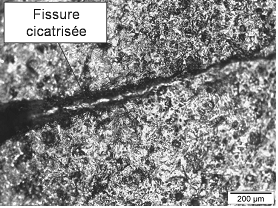Self healing vitreous composition, their preparation and uses
Référence
02782-01
Mots-clés
Ceramic, Virto ceramic, Self healing, SOFC, Water hydrolysis
Statut des brevets
French patent application FR0953490 filed on May 27th, 2009 entitled « Composition vitreuse autocicatrisante, procédé de préparation et utilisations »


Inventeurs
Lionel MONTAGNE
François MEAR
Daniel COILLOT
Statut commercial
Research agreement, exclusive or non exclusive licenses
Laboratoire
Catalysis and Solid-State Chemistry Unit (UCCS) CNRS UMR8181, France, http://uccs.univ-lille1.fr/spip.php?rubrique1
Description
CONTEXT
Glasses and vitreous ceramics are stiff materials widely used in the industry, in particular for sealing joints in diverse high temperature devices (500 to 900 °C). Among such devices, we can mention for example fuel cells (more particulary SOFC).
TECHNICAL DESCRIPTION
This is thus the aim of this invention to provide a composition of glass or vitreous ceramic showing self healing property in a fast way in the temperatures range of 400 to 900 °C. This self healing composition consists in at least one vitrous matrix and eventuallyn, one or more oxide forming elements andone or more modifiying oxides. Furthermore this composition contains solid particles opf an healing component chosen among vanadium and ist alloys. Vanadium gives to the composition self healing properties for temeratures as low as 400 to 500 °C, that is a temperatue range much lower than that known from state of the art self healing of non polymeric materials. The healing component is chosen with regard to the temperature of use of the system which includes the composition.

Healed glass fracture
BENEFITS
No need to heat the equipment above the softening temperature which may destroy the system including the composition.
Healing at low temperature ie temperature of use of the equipment which can be adapted by the use of « the right healing element ».
Healing quicker than for known materials like B4C.
INDUSTRIAL APPLICATIONS
Sealing of high temperature components like Solide Oxide Ful Cells (SOFC) or water hydrolysis equipement for Hydrogen production
For further information, please contact us (Ref 02782-01)
Besoin de plus d'informations ?
Nous contacterTechnologies Liées
-
16.04.2014
Multi-color luminescent screens for label-free bio-imaging
Dispositifs & Instruments, Matériaux – Revêtements 04585-01
-
04.02.2014
Transparent glass and ceramic glass in a large wavelength bandwidth (from visible to infrared 6µm)
Matériaux – Revêtements 05728-01
-
04.10.2013
Carbon fibres reinforced with Carbon Nanotubes
Matériaux – Revêtements 86312-01 / 02371-01 / 04669-01 / 04677-01